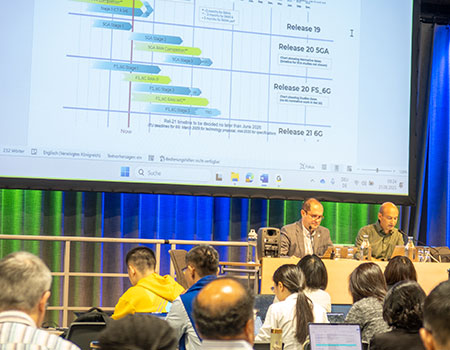Global outlook for mobile networks and devices
August 2020
By Joe Barrett, President - Global Mobile Suppliers Association (Article first published in HIGHLIGHTS Issue 01, Sept. 2020)
Despite the slowdown in 5G subscriptions in some markets due to Covid-19, other markets have compensated with the total forecast for 5G subscriptions by end of 2020 increasing. However, in addition to faster mobile broadband, the value of 5G will be in new services, not new subscriptions, as 5G technology is deployed in additional spectrum offering greater capacity and download speeds to open up sections of industry looking to enhance productivity, streamline process controls and ultimately, reduce costs.
Networks
Mobile network deployment is focused on 5G in 2020 with 388 operators investing in 5G network technology by the end of June. Of these, 102 networks were commercial. All have been based on the 3GPP Non-Stand-Alone (NSA) specification with the focus on enhancing existing 3GPP 4G mobile broadband networks with higher data rates and more reliable connectivity. That focus is now shifting to Stand Alone (SA) with 5G New Radio (NR) and 5G core (5GC) architecture required to deliver greater speed, flexible network design, low latency and operational costs savings needed to delivery specific mobile services to support the digitization of industry.
Mobile network operators (MNOs) who will launch 5G in the coming months may skip NSA and go straight to SA-5G-NR with 5GC to leverage new service opportunities in vertical industries. The industry is deploying 4G-5G in the oil and gas sector, ports, airports, mining, manufacturing and utilities. Interest in localised stand-alone private 4G or 5G networks is also growing as industry sees mobile as a reliable high-performance, secure access technology to meet business critical communications.
4G-5G Ecosystem
The 5G ecosystem of devices and chipsets has continued to grow swiftly in 2020. We are reporting 317 announced 5G devices by end of June, with a continued rapid rise of commercially available 5G devices, now at 135. This is a 60-70% growth compared to January 2020. There are 16 different form factors with Smartphones/phones and Customer Premises Equipment (CPE) for Fixed Wireless Access accounting for almost 70% of announcements.
Fixed Wireless Access (FWA) has seen growing interest due to Covid-19 and the demand for a reliable home broadband experience. At least 406 MNOs have launched FWA service with many MNOs also rapidly increased network capacity to satisfy demand that shifted from cities to remote homeworking demonstrating the flexibility of using mobile as the primary broadband service or to enhance an existing fixed broadband service.
The 4G ecosystem is also growing. 831 new 4G devices were announced in the first 6 months of 2020. 394 (47.4%) were smartphones/phones, 98 of which were Cat-12 device capable or higher.
Spectrum
After the success of gaining high-band millimetric wave spectrum for 5G mobile at the WRC-19 conference in November 2019, with more than 11 GHz of spectrum available in most countries for 5G, the WRC-23 spectrum focus has now moved on to additional mid-band and low-band spectrum to support long term market growth in the second half of this decade. Regulators are actively licensing 5G and GSA recommends that large contiguous amounts of harmonized spectrum, with suitable regulatory conditions, is made available including low-bands 600/700 MHz, mid-bands 2.3, 2.6, 3.3-4.2, 4.4-5 GHz and high bands 24.25-29.5/37-43.5/45.5 GHz – 47.2/47.2 – 48.2 GHz.
High-band spectrum such as 26/28/40 GHz delivers extreme capacity and 800-1000 MHz of contiguous spectrum will be needed per network as we go into 2021.
Mid-band spectrum provides such as 3.4-4.2GHz enables Coverage & Capacity with 80-100 MHz per MNO needed.
Low-band offers Extended Coverage with up to 20 MHz channel bandwidth needed from 2020.

5G
As noted earlier, there is a growing market for stand-alone private 4G and 5G networks for vertical industries. For example, regulators in Finland, Germany, Japan, UK and Sweden have either set aside spectrum for enterprise use or are considering this approach. The Citizens Broadband Radio Service (CBRS) action of band 48 (3.55 GHz – 3.70 GHz) in the US is also expected to expand the private network space. MNOs have been providing private networks using licensed spectrum for many years and are a good route for enterprise based private 4G or 5G. Some enterprise companies may however wish to share MNO spectrum or access their own. We support the use of MNO spectrum, sharing spectrum and dedicated spectrum for enterprise networks, depending on application and needs.
Conclusion
Around 10% of MNOs have commercially launched 3GPP compliant 5G networks and we expect this to accelerate as the industry fully adopts 5G in 2020 and 2021. The devices ecosystem is developing faster than the 4G ecosystem with a wide range of devices coming to market.
By the end of 2021 we expect closer to 40% of MNOs will have launched 5G networks.

 Partners News
Partners News 




